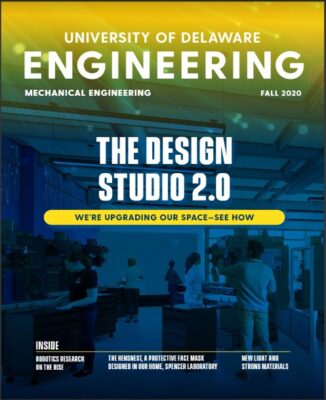The Story of How Delaware Student-Athletes Benefit From the College of Engineering
At Delaware Athletics, Community, and Campus Recreation, the mantra “Hens Supporting Hens” is fulfilled not only in the Cockpit student section on gamedays, but also behind the scenes through collaboration between DACCR and the University of Delaware College of Engineering.
In a partnership epitomizing the symbiotic relationship between academics and athletics at UD, Delaware engineering students have been meeting sports performance needs of the Blue Hens since 2017.
Through several channels, including the University’s senior design course, clinical immersion course, and Engineering, Exercise, and Sports elective, Hengineers are a valued and prioritized resource for the Delaware Sports Performance department to deliver student-athletes customized wearable solutions in rehabilitation and injury prevention.
Dr. Sarah Rooney instructs the Engineering, Exercise, and Sports elective and was involved in one of the earliest projects that saw Blue Hen students enhance the student-athlete experience of fellow Hens.
“From the student perspective, the most valuable thing is really being able to interface with somebody who has a true clinical need,” Rooney said.
Students strive to gain a complete understanding of an unmet need through regular communication with sports performance staff and student-athletes. The results are rewarding.
“The students view it as very impactful,” Rooney said. “So they’re actually able to see the application of their engineering work.”
One such application was 2017 senior design students’ thumb brace for baseball catchers. The brace, designed to be customizable and fitted with a strap, was created to address the hyperextension to which catchers are prone, preventing the common injury.
Student-athlete feedback on the brace confirmed its comfortable and quick application.
“They’re understanding and receptive to working with our students, and they provide really critical feedback,” Rooney said of DACCR.
“Continuously along the way, our partners in UD athletics have been able to give our students effective feedback to make sure that their designs are actually useful.”
Deputy AD, Sport Performance & Campus Recreation Dan Watson echoes the sentiment of the two-way street connecting DACCR and the University’s robust engineering program.
“We are the anti-silo,” Watson said. “A lot of athletics programs across the country have kind of siloed in and really don’t want to interact with the campus. We recognize the amazing people on campus, the students and faculty, staff, and we’re looking every which way to connect.”
That mindset is the foundation for all the benefits that the partnership reaps.
“We’re customizing a lot of these products to the athletes,” Watson said. “The fit and the comfort level is going to be far superior to anything that you can buy on the market, sort of off-the-shelf type of situation.”
In one instance of a custom piece expediting recovery and return to play, Watson recalls a product created for a student-athlete coming back from a hand fracture.
“We made a graphite protective piece that was [designed] from a body scan of his,” Watson said, “able to be produced to completely fit his hand unlike any other’s hand. Coming back from that fracture and having that customizable, protective piece in place that fit him perfectly was great.”
Fittingly, the custom equipment has its origins partly in the work of a Blue Hen student-athlete.
2016 field hockey national champion Kiki Bink, who majored in mechanical engineering with a minor in biomechanical engineering at Delaware, was among the first senior design engineers who worked on and saw to actualization a high-ankle-sprain brace for sports performance. The custom piece facilitated by 3D-scanning of the student-athlete is still used today in getting student-athletes back on the field more promptly than the national average, Watson said.
Stemming from DACCR’s involvement with engineering at the University, the department was invited to the HensWEAR collaborative, which unites the College of Engineering, the College of Health Sciences, and fashion and apparel studies. The group’s design of wearables intends to improve mobility and functionality, making it a “natural fit” for athletics, Watson added.
According to Watson, one of the successes to follow was the mechanical hamstring that aids student-athletes rehabbing a hamstring strain.
All the while, though, as Blue Hens resume competition empowered by gear produced right in Newark, engineering students through the years have equally benefited.
“It’s amazing how much growth can occur in just a single semester,” Rooney said, “and our partners with UD athletics have helped foster that growth in our students.”
By: Daniel Steenkamer
Originally appeared on BlueHens.com

